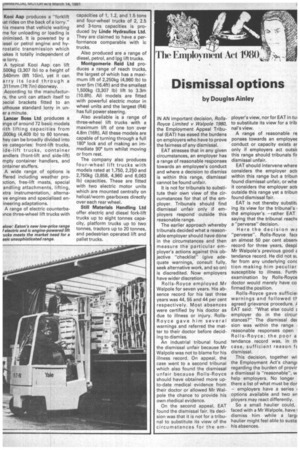Dismissal options
Page 33

If you've noticed an error in this article please click here to report it so we can fix it.
by Douglas Ainley IN AN important decision, RollsRoyce Limited v Walpole 1980, the Employment Appeal Tribunal (EAT) has eased the burdens on employers who have to prove the fairness of any dismissal.
EAT stresses that in any given circumstances, an employer has a range of reasonable responses towards an employee's conduct and where a decision to dismiss is within this range, dismissal cannot be found unfair.
It is not for tribunals to substitute their own view of the circumstances for that of the employer. Tribunals should find dismissal unfair only if employers respond outside this reasonable range.
The earlier approach whereby tribunals decided what a reasonable employer should have done in the circumstances and then measure the particular employer's actions against this objective "checklist" (give adequate warnings, consult fully, seek alternative work, and so on) is discredited. Now employers have wider discretion.
Rolls-Royce employed Mr Walpole for seven years. His absence record for his last three years was 44, 55 and 44 per cent respectively. Most absences were certified by his doctor as due to illness or injury. RollsRoyce gave him several warnings and referred the matter to their doctor before deciding to dismiss.
An industrial tribunal found the dismissal unfair because Mr Walpole was not to blame for his illness record. On appeal, the case went to a second tribunal which also found the dismissal unfair because Rolls-Royce should have obtained more upto-date medical evidence from their doctor or allowed Mr Walpole the chance to provide his own niedical evidence.
On the second appeal, EAT found the dismissal fair. Its decision was that it is not for a tribunal to substitute its view of the circumstances for the em
ployer's view, nor for EAT in tut to substitute its view for a trib nal's view.
A range of reasonable re ponses towards an employee conduct or capacity exists ar only if employers act outsit this range should tribunals fir dismissal unfair.
EAT should intervene where considers the employer actt within this range but a tribun found dismissal unfair, or whe it considers the employer actt outside this range yet a tribun found dismissal fair.
EAT is not thereby substitt, ing its view for the tribunal's , the employer's —rather EAT saying that the tribunal reacht a "perverse" decision.
Here the decision we "perverse". Rolls-Royce fact an almost 50 per cent abseil( record for three years, despi Mr Walpole's previous good e tendance record. He did not st. fer from any underlying conc tion making him peculiar susceptible to illness. Furth, examination by Rolls-Royce doctor would merely have co firmed the position.
Rolls-Royce gave sufficiel warnings and followed th agreed grievance procedure, / EAT said: "What else could C employer do in the circur stances?" The dismissal det sion was within the range , reasonable responses open • Rolls-Royce; the poor a tendance record was, in th case, sufficient reason ft dismissal.
This decision, together wit the Employment Act's changt regarding the burden of provir a dismissal is "reasonable", w help employers. No longer there a list of what must be dor — employers have a series options available and two en players may react differently.
So a small haulier could, faced with a Mr Walpole, have 1 dismiss him while a largi haulier might feel able to susta his absences.




























































































